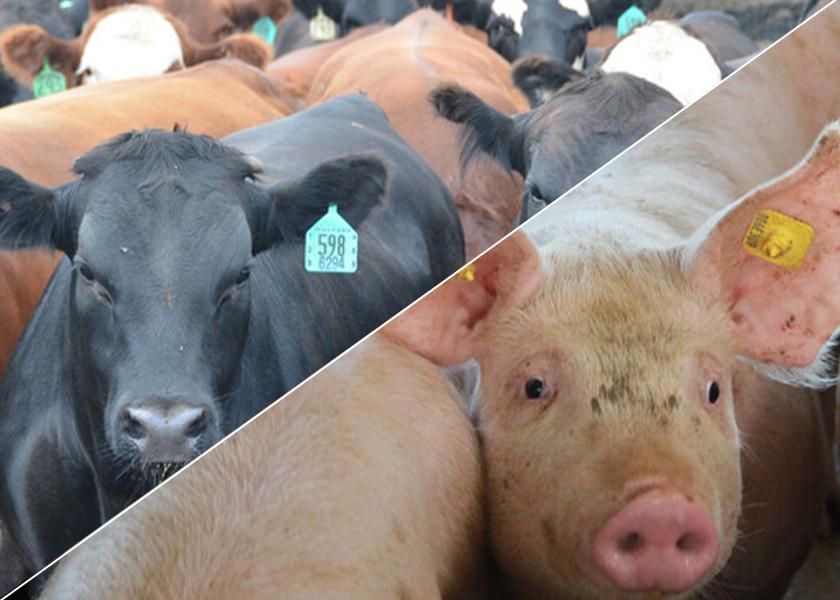Livestock Analysis | September, 2022

Price action: October lean hog futures led the complex higher Friday, rising $1.05 to $93.175, up $3.15 for the week and the highest closing price since Aug. 30.
5-day outlook: Hogs futures closed at a high for the month as the market extended Thursday’s rebound from two-month lows. While cash hog prices extended a late-summer slide, wholesale pork values firmed this week. Traders continue to narrow October futures’ discount to the CME lean hog index but the gap still remains unusually wide give the cash benchmark’s historical tendency to strengthen into mid-October. The index fell $1.22 today to $100.26 (as of Sept. 7), near a four-month low, but the rate of decline appears to be slowing. After averaging around $1.50 per day over the past two weeks, the preliminary reading for Monday’s index is expected to fall 69 cents to $99.57. That would put October futures at a discount of $6.395 to the index, less than half the gap at the end of August. Port cutout values rose $1.82 early today to $104.26, up from $102.25 at the end of last week.
This week’s preliminary hog slaughter totaled 2.243 million head, just slightly under the year-ago figure at 2.248 million head. Next week’s slaughter may fall well short of the year-ago figure, which would confirm the relative tightness of supplies. We also suspect these conditions (firm pork values and tighter market-ready hog numbers) will translate into a rebound in cash hogs in the weeks ahead.
30-day outlook: We expect hog and pork values to soon turn seasonally higher. The 10-year average shows a strong tendency for the hog index to rise through the end of September and possibly into mid-October. The rise isn’t always particularly large, but having the market simply trade sideways for several weeks can shift the fall outlook significantly higher. Traders await USDA’s quarterly Hogs & Pigs report Sept. 29. The population numbers suggest the September 1 totals will remain slightly below year-ago levels. However, if the long-term trend of litter sizes rising about 1% per year were seen as having resumed during summer, the population might rise above year-ago levels. We doubt that will happen, due in part to the elevated cost of feed and to the bearish outlook built into deferred hog futures.
90-day outlook: The fourth-quarter outlook signals lower hog and pork prices into December. Hog supplies routinely rise substantially during fall, whereas demand for most pork cuts, other than hams, tends to be seasonally weak. Futures traders anticipate little market strength in September, followed by sizeable losses into mid-December. Long-term averages imply a much smaller seasonal decline, but traders are likely taking a significant cue from 2021, when the hog index fell to about $70.00 around Thanksgiving before turning higher. Prices may prove seasonally weak but we still think the anticipated decline will be decidedly smaller than what’s implied by futures.
What to do: Be prepared to extend feed coverage when market bottoms are in place.
Hedgers: Carry all risk in the cash market for now.
Feed needs: You are hand-to-mouth on corn-for-feed and soybean meal needs.
Price action: October live cattle rose $1.30 to $145.675, up $1.125 for the week and the contract’s highest closing price since Aug. 17. October feeder cattle gained $1.175 to $185.575, up 62.5 cents for the week.
5-day outlook: October live cattle posted a technically bullish weekly high close, which may generate followthrough speculator buying early next week. Feeder cattle also posted firm gains despite strength in corn futures. Futures continue to draw support from expectations for tight supplies of market-ready animals in the months ahead, which many traders appear to believe will pull the cash market out of a recent slump. Live steers averaged $141.42 this week through Thursday morning, down $3.37 from last week’s average. Wholesale beef prices continued to slide, as Choice beef cutout values fell 77 cents to $257.24, the lowest since mid-May.
30-day outlook: Feeder cattle futures hold large premiums to fed cattle counterparts, especially considering higher feed costs. The ongoing liquidation of cattle herds will likely significantly reduce yearling supplies in coming months. Cattle slaughter has averaged about 2% over year-ago levels since early summer, with the implied marketing rate exceeding the approximate 1% annual gain in the feedlot population in recent months. Beef production has also seen modest year-to-year gains due to minimal gains in cattle weights, which suggests the market-ready supply of feedlot cattle will remain tight.
90-day outlook: U.S. equities this week turned in a strong performance, and any followthrough strength this fall may encourage commodity market bulls. The global economy is key to the longer-term outlook. Recent U.S. economic data has been mostly upbeat, gasoline prices are down sharply from a June peak, consumer attitudes seem to be improving and there are early clues inflationary price pressures may be ebbing a bit. These trends, if continued, are bullish for the cattle market.
What to do: Be prepared to extend feed coverage when market bottoms are in place.
Hedgers: Carry all risk in the cash market for now.
Feed needs: You are hand-to-mouth on corn-for-feed and soybean meal needs.






